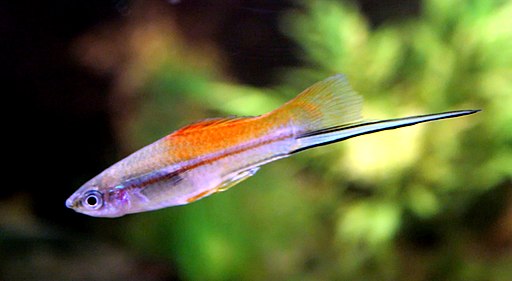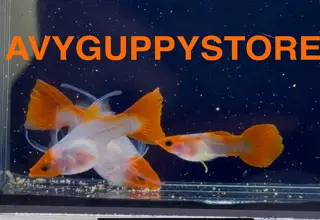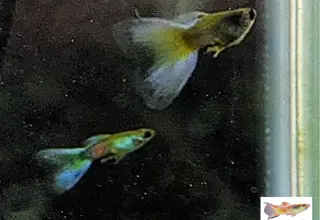Bumblebee Platy: Care, Size, Appearance & More
Posted by on 03/18/2023
We use affiliate links and may receive a small commission on purchases.
If you're looking for a shoaling fish for a freshwater aquarium, look no further than the Bumblebee Platy. This uncommon variant of the more well-known Southern platyfish makes for a great addition to a planted aquarium or a nano tank. Best of all, these fish are relatively low maintenance and easy to care for.
In this post, we'll cover everything there is to know about the Bumblebee Platy. We'll review their size, lifespan, appearance, and diseases that they may be exposed to. We'll even discuss breeding this unique-looking fish in captivity.
December's Giveaways on Light Fish
Species Summary
The Bumblebee Platy (scientific name: Xiphophorus maculatus) is a unique platyfish color morph that is the result of selective breeding. Breeders will select fish with bright coloration in hopes that their offspring will produce the desirable coloration seen in the parent fish. Different color morphs are commonly found in platies, and this is widely attributed to the fact that these fish readily breed in captivity.
In the wild, the Bumblebee Platys naturally-occurring relative can be found throughout North and Central America, where it lives in slow-moving waterways and feeds off of insect larvae and other small crustaceans. Hobbyists familiar with Swordtails will likely notice their similarities in appearance. Xiphophorus hellerii, also known as the Green Swordtail, shares the same genus as the Bumblebee Platy, allowing both species to be successfully crossbred.

Appearance
Bumblebee Platies are without a doubt interesting-looking fish. This fish features bright yellow lips, followed by black eyes with yellow eyelids. The front portion of the fish features a dark black coloration, which in some fish will show small iridescent flakes of green. Platies are ray-finned fish, and their pectoral, caudal, and dorsal fins feature a translucent yellow coloration. Their bodies are slender and torpedo-shaped, which adds to their maneuverability in the water.
At first glance, it's easy to understand why the fish has earned its common name. The coloration of these fish closely resembles that of a bumble bee. In an aquarium, the bumblebee platy will pair well with other similarly-colored species, such as assassin snails.
🛒 Shop Freshwater Fish on Light Fish
Male vs Female
Hobbyists looking to determine the difference in gender between a Bumblebee platy should closely examine the fish's anal fin and overall size.
Females will tend to be a bit rounder in shape, and will also have a round anal fin, while males have a longer and thinner anal fin that tapers to a point.
Size
Bumblebee platies are small fish, and when fully grown, will reach about 2-3 inches in length.
Females tend to be about half an inch longer than males, but the overall size of these fish makes them excellent additions to nano-sized aquariums.
Bumblebee Platy Care
One of the best parts about owning Bumblebee platies is that they're relatively easy to care for. They aren't as demanding as more sensitive fish when it comes to water parameters, making it no surprise that the Bumblebee platy, or platies in general - are a great choice for those new to the aquarium hobby.
Still, as a hobbyist, it's your responsibility to provide the best care possible for these living creatures, and you'll want to be aware of some of their care requirements.

Lifespan
When provided a pristine environment safe from predators, and a well-balanced diet, the Bumblebee platy should live for about three years in an at-home aquarium.
It's important to provide stable water conditions for the duration of a fish's life, including bumblebee platies. Doing so will reduce their levels of stress, which if increased, can weaken their immune system making them more susceptible to potential diseases and infections.
Tank Size
At a minimum, you should have at least a 10-gallon aquarium before adding bumblebee platies.
Although these fish are small, they're not as tiny as ember tetras , and still require a suitably-sized tank.
Water Conditions
Although these fish come from environments where pH tends to be a bit on the higher side, Bumblebee platies have earned a reputation of being quite adaptable when it comes to water chemistry.
Platies will live comfortably in a fully cycled tank as long as the water parameters are within the following ranges:
Temperature Range: 70°F-82°F
pH: 6.8-8.5
Ammonia: 0ppm
Nitrite: 0ppm
Nitrate: 0-40ppm
Tank Setup
When it comes to tank setup, bumblebee platies aren't very demanding, and won't require any expensive equipment to maintain.
Live, easy-to-care-for plants are a beneficial addition to any freshwater aquarium, and plants such as hygro and taiwan lilies make for excellent options.
When it comes to a substrate, almost any aquarium-rated substrate will do, but we strongly recommend CaribSea's eco-complete for its aesthetic and added nutrients. While the additional nutrients in the substrate won't be beneficial for your bumblebee platies, they will aid in plant growth if you choose to include live plants.
Platies, including the Bumblebee color morph, do not require an additional powerhead and will do well with a HOB (hang-on-back) or canister filter rated for your aquarium size.
For Hardscape, natural driftwoods such as Mopani and Cholla wood will work well in a platy tank, and stones such as dragon stones and seiryu stones can be used to create unique-looking aquascapes.
Common Diseases
Bumblebee platies are susceptible to common diseases that affect most aquarium fish. You'll want to prevent a disease from taking hold by performing regular water changes, and you should regularly test your water with a reliable test kit to ensure water parameters fall within the recommended ranges.
Some of the more common diseases to affect the bumblebee platyfish are freshwater ich and epistylis, which we cover in more detail in another one of our blog posts: Epistylis vs Ich: Transmission, Similarities, Differences, and Treatment.
Food & Diet
Bumblebee platies should be fed nutrient-rich flake food and pellet food, 1-2 times per day, and should be fed no more than what they can consume over a 2-3 minute period.
As an occasional treat, you can supplement their diet with bloodworms and freeze-dried brine shrimp.
Behavior and Temperament
In many ways, Bumblebee Platies are the quintessential aquarium fish. Their peaceful and laid-back personalities make them the perfect beginner fish, and they can co-exist with other types of fish, including their own species. They tend to hang out in the middle of the water column and are quite active swimmers, often chasing each other around the tank in a playful manner.
Bumblebee platies can live comfortably alone or in small groups of at least 3. They can also co-exist with other Southern Platy color morphs and variations of the Green Swordtail, and will frequently interbreed if both males and females are present in the tank.

Tank Mates
Bumblebee platies can coexist with other peaceful freshwater fish and invertebrates, presenting hobbyists with many attractive stocking options.
Some popular tank mates for the bumblebee platy include:
Many other peaceful schooling fish are also suitable and will readily share a tank with other Bumblebee platies and Southern platy color morphs.
Aggressive fish, including cichlids such as the Electric Blue Jack Dempsey, Cuban Cichlid, and Red Dragon Flowerhorn Cichlid should be avoided.
Breeding
Bumblebee Platies are live-bearing fish. For those unfamiliar with the term, livebearing fish will retain their fertilized eggs inside of their bodies and will release their young once they're ready to swim throughout the water column.
The birthing method of a livebearer fish is quite rare in nature, as most fish will guard fertilized eggs until they hatch into fry.
In an aquarium environment, there are some pros and cons to livebearers. A single female can release over 50-100 fry directly into your tank, and these fry will eventually transition into adult fish. For breeders interested in selling fish for profit, you'll have many fish to sell. However, those of us who are hobbyists will now have a large amount of new fish to care for.
Interestingly, platies will readily consume fry as a meal, which can help self-regulate their population size. However, if your tank has plenty of hiding spots and small caves, many of the fry will survive in the tank and transition to adults.
As long as male and female platies are present in a tank, breeding will frequently occur as long as water conditions remain stable. For those looking to increase the breeding frequency, you can raise your aquarium temperature by a few degrees.
Platies, similar to guppies, are frequent breeders and are some of the easiest to breed fish in the aquarium hobby.
Where To Purchase
While not as common as some of the other color morphs, Bumblebee Platies have occasionally been sold on our marketplace, and can also be found on other online marketplaces such as eBay .
It's always worth contacting your nearest in-person fish store as well to see if they have Bumblebee Platies in stock.
In Conclusion
The Bumblebee Platy is a great choice for beginners new to fish keeping that want an easy-to-care-for fish that features a rare and distinct color pattern. Although it can be difficult to find this platy color morph for sale, owning one is an incredibly rewarding experience, and hobbyists will appreciate their bright yellow coloration and peaceful temperament.
Do you plan on adding a Bumblebee platy to your fish tank? Let us know in the comments, and be sure to check out our marketplace and community forum where you can discuss fishkeeping with other aquarium hobbyists.
December's Giveaways on Light Fish






